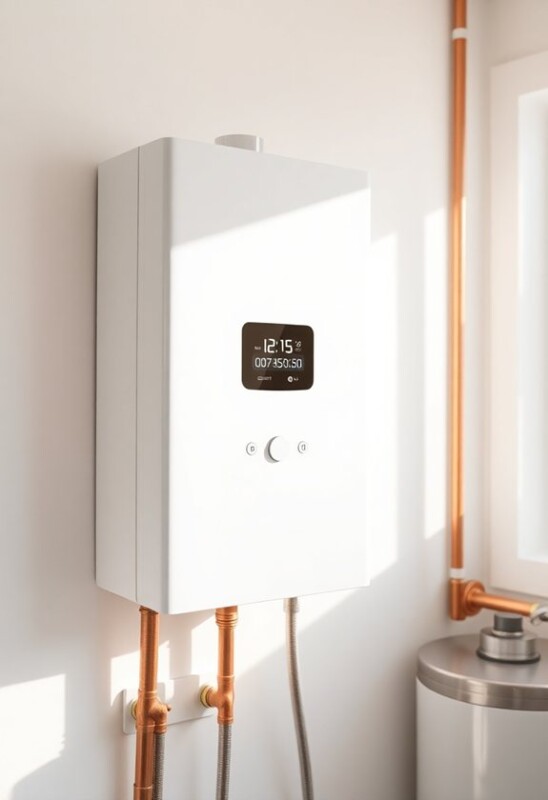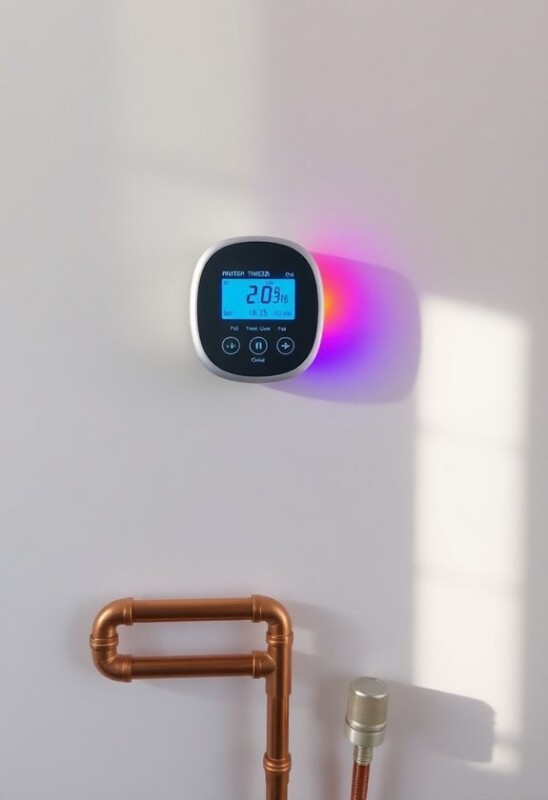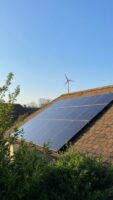You’ll greatly reduce your carbon footprint and energy costs with a sustainable water heater timer system. These smart systems cut household CO₂ emissions by up to 58% and save over 2,000 pounds annually. With payback periods of 6-12 months and annual savings of $292-$438, the investment makes financial sense. Modern timers integrate seamlessly with renewable energy sources and smart home technology, optimizing usage during off-peak hours. The data-driven benefits of these systems extend far beyond basic energy savings.
Key Takeaways
- Smart water heating systems significantly reduce household carbon emissions, preventing up to 12 tons of CO₂ over their lifespan.
- Timer systems deliver substantial cost savings of $292-$438 annually through reduced utility bills and peak-rate avoidance.
- Integration with renewable energy sources allows water heaters to act as thermal batteries, optimizing energy storage and usage.
- Investment payback occurs within 6-12 months, with additional benefits from tax credits and utility company incentives.
- Modular design ensures future compatibility with emerging technologies while maintaining robust cybersecurity for smart home integration.
The Environmental Benefits of Smart Water Heating

As utilities endeavor to reduce their environmental impact, smart water heating systems have emerged as a pivotal solution for lowering household carbon emissions.
You’ll achieve up to 58% CO₂ reduction by upgrading to eco-friendly technology like heat pump water heaters, which save over 2,000 pounds of emissions annually – equivalent to planting 17 trees for a decade.
Smart energy conservation features automatically shift water heating to off-peak hours when grid emissions are lowest.
With electricity’s carbon intensity dropping 36% since 2007, your HPWH’s environmental benefits increase as the grid integrates more renewables.
The EPA confirms these systems prevent 12 tons of CO₂ over their lifespan.
Understanding Energy Efficiency Metrics
When selecting an energy-efficient water heater, you’ll need to understand two critical performance metrics: Energy Factor (EF) and Uniform Energy Factor (UEF).
These efficiency standards measure how effectively your heater converts energy input into heated water while accounting for standby losses.
Electric heaters achieve EF ratings of 0.7-0.95 through direct energy conversion, while gas units range from 0.5-0.8.
Oil-based systems fall between 0.7-0.85. For the most accurate comparisons, you’ll want to focus on UEF ratings within the same category or “bin.”
Heat pump water heaters demonstrate superior efficiency with EF ratings of 1.5-2.0, making them an excellent choice for energy-conscious consumers.
Cost Savings and Return on Investment
Understanding efficiency metrics sets the foundation for evaluating the financial benefits of water heater timer systems.
Your cost analysis starts with a modest investment of $50-$200 for the timer, plus potential installation costs of $150. You’ll see your investment returned within 6-12 months through reduced utility bills.
A thorough savings projection shows annual reductions of $292-$438 for typical households, with further benefits from tax credits and utility company incentives.
You’ll enhance returns by programming your timer to avoid peak-rate periods and optimize solar energy usage. The system also extends equipment lifespan, reducing long-term maintenance costs while protecting against rising energy prices.
Smart Integration With Renewable Energy
Modern water heater timer systems seamlessly integrate with renewable energy sources through advanced grid-interactive controls, enabling you to optimize clean energy utilization while minimizing costs.
Through smart energy management, your water heater becomes a thermal battery, storing up to 26 kWh of energy in a 105-gallon unit when renewable generation peaks.
The system’s controllers dynamically adjust charging based on real-time solar and wind availability, while heat pump technology further reduces grid dependency.
Renewable energy integration features include variable pricing optimization, automated load shifting during high renewable periods, and remote monitoring via smartphone apps.
You’ll benefit from hybrid technology that combines heat pump efficiency with electric resistance backup, maximizing renewable utilization.
Peak Load Reduction and Grid Impact
Smart water heater timers play a key role in reducing peak grid demand, building upon their renewable energy capabilities.
By shifting your water heating operations to off-peak hours, you’ll help maintain grid stability while ensuring consistent hot water availability through effective insulation systems.
You’ll benefit from lower utility costs by avoiding expensive peak-rate electricity consumption.
The timer automatically manages heating cycles during periods of lower demand, yet provides override functions when needed.
This strategic approach to water heating prevents unnecessary strain on the power grid during high-demand periods, contributing to a more resilient and efficient electrical infrastructure.
Modern Timer Features and Capabilities
As water heater technology continues to evolve, today’s timer systems offer an extensive suite of programmable features that improve both efficiency and convenience. You’ll find sophisticated programmable schedules that align with your household routines, while user friendly interfaces make operation intuitive.
| Feature | Benefit | Integration |
|---|---|---|
| Smart Apps | Remote Control | IoT Systems |
| Voice Control | Hands-free Operation | Digital Assistants |
| Touch Display | Precise Adjustment | Cloud Updates |
| Auto-learning | Pattern Recognition | Usage Analytics |
These modern capabilities enable you to optimize heating cycles through touchscreen controls, smartphone connectivity, and intelligent scheduling that adapts to your usage patterns. The system’s self-diagnostic alerts guarantee reliable operation while minimizing maintenance requirements.
Compatibility With Different Heating Systems
Building on advanced timer features, water heater timer systems demonstrate broad compatibility across multiple heating system types.
You’ll find seamless solar compatibility with controls that optimize energy usage during peak sunlight hours. The system’s heating system adaptability extends to both gas and electric units, requiring no major modifications to existing setups.
For your smart home integration needs, these timers work with third-party automation devices through plug-and-play connectivity.
Before installation, you’ll need to verify your system specifications, including make, model, and voltage.
Whether you’re operating a residential or light commercial setup, these timers support diverse usage patterns while maintaining safety and reliability.
Installation Best Practices and Tips
When installing a water heater timer system, proper wiring connections and grounding procedures guarantee both safety and peak performance.
Following crucial installation guidelines, you’ll need to verify correct wire placement and secure grounding.
For ideal wiring safety, follow these critical steps:
- Connect the black wire from your breaker to LINE 1 and white wire to LINE 3 in your timer.
- Link the timer’s black wire to LOAD 2 and white wire to LOAD 4, connecting to corresponding heater wires.
- Secure all ground wires to green screws and use wire nuts for reliable connections.
Remember to use 10/2-with-ground wiring and always turn off power before installation.
Long-term Sustainability Advantages
Installing a sustainable water heater timer system delivers multiple long-term advantages that extend far beyond initial energy savings. You’ll benefit from sustainable practices that improve system longevity while promoting energy conservation through optimized usage patterns.
| Benefit Category | Impact | Sustainability Outcome |
|---|---|---|
| Energy Use | -30% consumption | Reduced carbon footprint |
| System Life | +5-7 years | Less frequent replacement |
| Resource Management | Scheduled heating | Minimized water waste |
| Economic Return | Lower utility costs | Ongoing savings |
| Environmental | Decreased emissions | Improved conservation |
These advantages compound over time, maximizing your investment while supporting broader environmental goals through reduced resource consumption and improved efficiency.
Future-Ready Home Energy Management
Modern water heater timer systems serve as the foundation for extensive home energy management, seamlessly integrating with smart technologies to enhance your entire household’s energy ecosystem.
As future energy demands evolve, your system adapts through:
- Automated coordination with solar panels, batteries, and EVs to increase renewable energy usage
- Smart technology integration that monitors real-time grid signals and adjusts to dynamic pricing
- Modular design that accommodates emerging technologies and demand-response programs
Your timer system’s scalable architecture guarantees you’re prepared for upcoming grid innovations while maintaining robust cybersecurity protocols.
You’ll benefit from continuous updates and compatibility with new smart home devices, positioning your household for tomorrow’s energy landscape.
Conclusion
By choosing a sustainable water heater timer system, you’ll optimize energy consumption, reduce your carbon footprint, and achieve significant cost savings of 10-30% annually. The system’s smart integration with renewable sources and peak load management guarantees maximum efficiency while future-proofing your home’s energy infrastructure. When properly installed and maintained, these systems deliver reliable performance and measurable environmental benefits for years to come.




